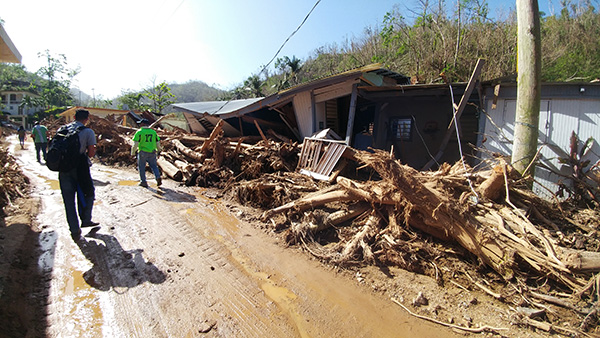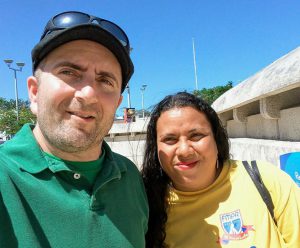
Brad Sigal, a staff member in the Department of Curriculum and Instruction, recently returned from an aid trip to Puerto Rico where he assisted the Puerto Rican Teacher’s Federation (FMPR) with their disaster relief work and educational advocacy to reopen public schools. He saw the devastation of hurricane Maria firsthand and witnessed the resilience of the communities one month after the hurricane hit while they were still dealing with power outages, food shortages, and a breakdown of infrastructure.
Sigal decided to go down to help after seeing the FMPR’s calls for help on Facebook. “They were organizing work brigades to clear roads and fix houses. I wanted to support the efforts,” he says.
The capital of San Juan, Sigal reported, was mostly without electricity and using generators to keep some homes and businesses electrified, including the international airport. The outlying cities were completely in the dark and still had roads covered in debris and homes with holes in the roofs or walls.

Sigal met teachers and families who were concerned that schools still weren’t open a month after the hurricane. He helped the FMPR organize to reopen schools, a defense against growing fears that schools would be privatized in the wake of hurricane Maria in a similar turn of events that saw 7,000 teachers fired and public schools shut down and converted to charter schools after hurricane Katrina in New Orleans.
Many schools have opened since he returned from his visit, Sigal says, largely because of the political activism by teacher’s union and a legal injunction where they forced the Department of Education to give a tally of which schools not open and why. He explains that schools were remaining closed because officials said there was infrastructure damage, but people had been using the cafeterias and schools as relief centers and were holding up well in that capacity. “Saying that the schools are not in condition to reopen didn’t make sense,” Sigal said of the situation.
Around 100 schools are still not open 70 days after the hurricane and so the work continues to save those schools and get them reopened to the students.
Sigal noted that most teachers still decided to go to their closed schools and help families in the buildings in order to maintain a connection with the community and continue to work.
“ I was amazed by the teachers and others I met. In the face of having to deal with their own personal crises of not having housing or food or electricity, they were also battling political issues with the school,” Sigal recounted. “The ability to do all that incredible.”



